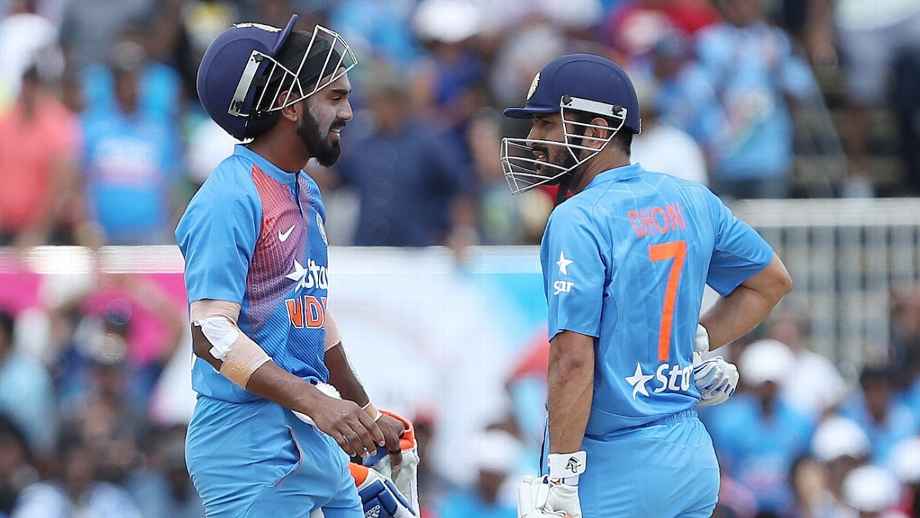
Gautam Gambhir has liked what he has seen of KL Rahul as a wicketkeeper-batsman in white-ball cricket. The former India opener reckons Rahul is the "apt replacement" for MS Dhoni in the shorter formats, particularly in T20 cricket, going forward.
Dhoni, 38, hasn't played any serious cricket since India's semi-final exit from the ODI World Cup in July 2019, following which Rishabh Pant and then Rahul have taken over keeping duties in white-ball cricket. IPL 2020 was widely seen as the one opportunity Dhoni had to make a bid for an international comeback before the T20 World Cup - scheduled for October-November 2020 in Australia - with India coach Ravi Shastri saying as much on more than one occasion.
With the Covid-19 pandemic potentially ruling out any IPL action this year, the door might just be shutting on Dhoni. Gambhir certainly thinks so.
"If the IPL does not happen this year, then it will become very difficult for MS Dhoni to make a comeback," Gambhir said, speaking on Star Sports Cricket Connected. "On what basis can he be selected since he's not been playing for the last one or one and a half years.
"The apt replacement for Dhoni could be KL Rahul. Ever since he has donned the keeper's gloves in white-ball cricket, I've seen his performance, both batting and keeping. Obviously his keeping is not as good as Dhoni's, but if you are looking at T20 cricket, Rahul's a utility player, can keep and bat at No. 3 or 4.
"If the IPL does not happen, then MS Dhoni's chances for a comeback look dim. Ultimately, you are representing India, so whoever dishes out the best performance and can win the match for India should play for the team. As far as his retirement plans go by, that's his personal choice."
Since taking over as India's white-ball keeper - temporarily at first, filling in for a concussed Pant, and then on a regular basis - Rahul's returns have been phenomenal. In ODIs, he's scored 303 runs in five innings at an average of 75.75 and a strike rate of 114.77, while batting mostly at No. 5. Opening the batting in T20Is, he's scored 224 runs at an average of 56.00 and a strike rate of 144.51.
MS Dhoni, in charge at Chennai Super Kings as usual BCCI
Former India opener Aakash Chopra, meanwhile, has suggested that Dhoni, who has been near-invisible in the media for a while now, might have unofficially retired from international cricket. Rather than being dropped after the 50-over World Cup, Chopra feels Dhoni made himself unavailable for selection.
"MS Dhoni has not told anyone anything," Chopra said on his YouTube show Cricket Aakash. "He has a different story. What almost everyone think is that he might return to the Indian team if he performs well in the IPL. But I personally feel he played his final match for India at Manchester against New Zealand.
"Since then, he has not made himself available to the team. He has not been dropped. I feel he has made up his mind that he is no longer going to play for India."
Rather than go out with an official announcement or a farewell game, Chopra believes Dhoni simply decided to walk away without a fuss, and will only play for India again if he's persuaded to by India's team management or the BCCI president Sourav Ganguly.
"Unless, of course, Sourav Ganguly, Virat Kohli or Ravi Shastri pick up the phone and tell Dhoni to help the team out in the T20 World Cup. If they tell Dhoni that they want him to play the World Cup, then there is a chance he could return," Chopra said. "Otherwise, in my opinion, Dhoni has made up his mind that 'I am not going to play, I don't need a farewell match. I came quietly, I will leave quietly'. He doesn't need grandstanding. He is not that kind of player. He doesn't want any noise. If the T20 World Cup gets pushed, then I don't think you will see Dhoni in India's blue jersey."
Whether Dhoni plays for India again or not, former India batsman VVS Laxman believes Dhoni will continue to play and perform for Chennai Super Kings for "the next couple of IPLs".
"I think playing for CSK will keep him going because he's supremely fit and age is just a number, and especially when someone like MS Dhoni is not only physically fit, but mentally very astute as a captain, as a leader he enjoys leading the CSK franchise," Laxman said in the same show. "He's been very successful doing that and as far as Dhoni's cricket is concerned, I'm sure you're looking forward to watch him play in the IPL. Not only this IPL, he will probably play in the next couple of IPLs, and then we will take a call about his future as a cricketer.
"But I think MS Dhoni will be very clear, as far as his plans are concerned, I'm sure he must have communicated that with [India captain] Virat Kohli, Ravi Shastri immediately after the 2019 World Cup in England. The new selection committee will have to sit down with MS Dhoni and understand his future, as far as Indian cricket is concerned. But MS Dhoni will continue to play for CSK and do well for CSK."